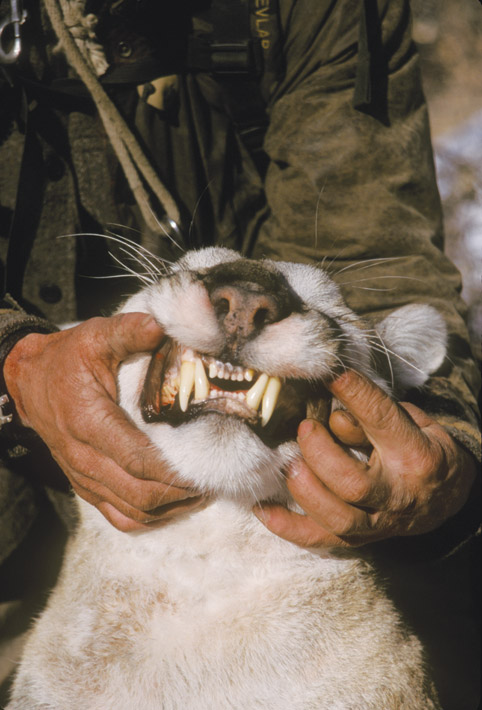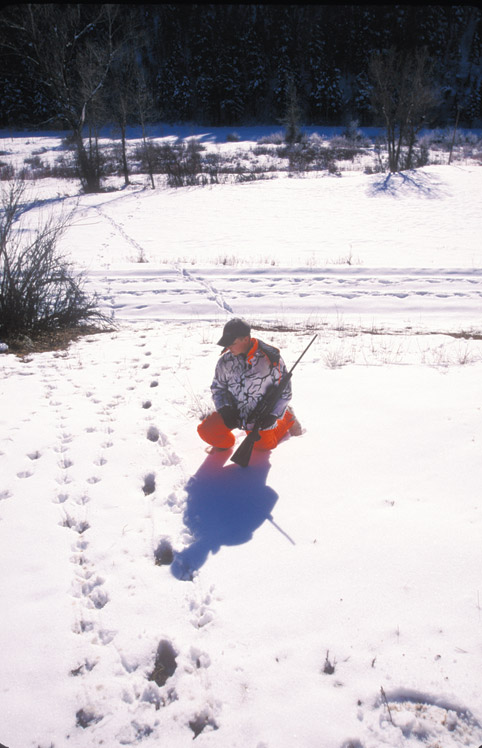 Predator Hunting: Hound Hunting Cougars
Predator Hunting: Hound Hunting Cougars
By Predator Hunting Editor Judd Cooney

We knew this hunt was going to be a little different when the cougar track split and went around both sides of a tree. When one of the sets of tracks split again, we knew we were on the track of not two but three mature toms traveling together—a truly unusual circumstance.
Our enthusiasm was somewhat tempered by the fact that we were busting through knee-deep crusted snow, and the dogs had long since gone out of hearing.
I was hunting with New Mexico cougar guide Dick Ray and one of his clients. Five grueling hours later, it became obvious we weren’t going to catch a cat that day as it was late afternoon and the dogs were still out of hearing. We agreed that Dick would stay on the track, and if he got to the treed dogs, he would spend the night and hopefully keep the cat up the tree until morning.
I, hopefully, would get the overweight client back to the truck alive. If Dick didn’t show in a reasonable amount of time, we were to assume he was spending the night with the dogs, find a warm place for ourselves to spend the night, and then return to look for him the following morning.
This was long before cell or satellite phones, and Dick didn’t believe in radio collars when chasing cougars.
I truly feared the client would collapse during the last half-mile out. But with less than an hour of daylight left, I finally got the exhausted man in the truck and headed down off the plateau.
I’d driven some 5 miles below where we’d left Dick when I pulled into an old abandoned homestead to listen for the hounds. Eureka! I heard a dog treeing less than a half-mile away, across a sagebrush flat in some ponderosa timber.
It took considerable cajoling to get the exhausted hunter back underway, and I eventually left him to follow at his own pace—either to the tree or back to the truck. I was headed for the tree. Frank, Dick’s best cat hound, was telling me in no uncertain terms that he was looking up at a treed cougar.
When I got to the huge ponderosa, with Frank bawling at the base, I could faintly hear other dogs treeing in a deep canyon a half-mile farther on.
Evidently, Frank thought I had things under control, because he took off to join the other dogs, leaving me with the tom and no bawling hound to keep it treed. The big cat started down the tree, and I grabbed a limb and swung at it, trying to make it go back up the tree. To my surprise and considerable relief, it worked.
By then the hunter was in sight, and I hollered to urge the hunter on. He was completely tuckered, and it took the last vestiges of his stamina to reach the tree.
The cat was all but invisible in the fast-fading light. But the man steadied himself and dropped it with the first shot.
We’d just gotten the cat back to the truck when we heard someone cussing us from a distance. It was Dick, and he had no idea who we were. He told us later he figured someone had heard his dog from the road and then sneaked in to steal the cat. He was fighting mad, though so wore out he probably couldn’t have done anything about it, anyway.
The dogs still had one or maybe both of the other cats treed, but neither Dick nor I had the gumption to find out that night. We returned at first light the next morning and picked up the exhausted dogs on the road.
There’s nothing quite as exhilarating as trudging through fresh snow under azure mountain skies, listening to the distant bawling of a pack of hounds trying to unravel the twists and turns of a cougar trail. The sight of those big pug marks lined out in the snow, partially obliterated by the trail of the pursuing hounds, is always enough to boost my adrenaline considerably.
Unfortunately, some of the exhilaration of my next cougar hunt was dampened by the fact that every 100 yards or so I had to stop and throw up all over the nice clean snow.
That hunt actually started the morning before. I was cruising the back roads looking for a fresh bobcat track for my two Plott hounds when halfway up a narrow canyon, I cut the track of a huge cougar crossing the roadway.
There was only a week left in the season, and I didn’t have a cougar license. But it was only mid-morning, and the sheer size of the track left little doubt.
I raced the 30 miles back to town and purchased a cougar license. A call home had my daughter Lisa on her way to meet me with two more hounds.
Colorado cougars are hunted on a limited quota system, which meant a permit was required in addition to the license, a permit only available at the area office in Durango, 60 miles away. Some serious salesmanship over the phone convinced someone in that office to issue a permit that day and put it in the mail.
Lisa showed up less than an hour later, dressed and ready for a cat chase.
Somehow, I managed to avoid a speeding ticket racing back to the cougar crossing, and by 2 o’clock, we were leading the dogs along the track. The dogs let us know quickly that it was hot enough to run, and after letting them jerk and drag us another 200 yards, we let them go.
When darkness descended several hours later, we were several miles from the road and had lost hearing of the dogs, so we decided to hike out and resume the chase in the morning.
Lisa couldn’t accompany me the following day, so I phoned a good friend and cat-hunting guide, Tony Hoza, from Norwood, Colorado.
He agreed to bring fresh hounds and meet me at the truck stop in Pagosa. He arrived well before daylight, and we stoked up on eggs, sausage, and pancakes.
Big mistake on my part. By the time we got back to the lion track in the canyon, my stomach was bubbling and boiling.
With Tony and three eager hounds urging me on, I made it back to the ridgetop where Lisa and I had turned back the previous evening. We discovered that my Plott hounds had split off on an almost equally large but fresher track, one that mingled with the first tom’s tracks before heading in another direction. I found out later that my hounds had treed this lion 5 miles down country and had kept it treed all night before giving up and going to a nearby rancher’s house.
On the hike in, I had tossed my cookies several times, and when it became apparent that I was slowing Tony, we agreed that he should go ahead, and if the dogs had the cat treed, he would stay at the tree with them until I arrived. I vowed to get to that tree no matter how long it took.
I’d shuffle a couple hundred yards, throw up, and then spend a few minutes munching snow to try to get the taste out of my mouth before heading out again.
Fortunately, the cat had traveled the mesa top much of the way with only occasional jaunts off into small side canyons. By noon, I could hear the hounds. The closer I got to the racket, the better I felt.
By the time I stood alongside Tony admiring the huge cat in the pine some 60 feet above, I felt fine.
Truthfully, I can’t recall much about the final few miles of that 10-mile chase. But every time I look up at the monstrous Boone & Crockett cougar on my trophy room wall, I’m thankful I made it.
The cougar is not a “do-it-yourself” hunt. Even though an occasional cougar is taken by a predator caller or someone in a blind at a watering hole, such kills are more luck than skill. Unless you live in lion country and have your own pack of trained hounds, hiring a guide is the only way to have a reasonable chance.
Whenever someone tells me hiring an outfitter and hunting behind his hounds is too easy, I ask them if they have ever actually done it. So far, all have admitted that they have not.
I suppose it can be easy. The guide could get on a smoking fresh track, and the dogs might tree the cat 100 yards from the truck. Oh, to be so lucky.
You and your guide are more likely to get on an old track and spend the next day or two cruising canyons and back roads, trying to cut down the distance between you and the cat, hoping to locate a track still fresh enough to turn the dogs on.
Once the dogs are loose on a track, no one has control of the hunt, and you must follow it to the end regardless of how impossible the going gets.
You may hike 20 miles through the mountains before the dogs get close enough to put the lion up a tree.
And, if upon closer inspection, the cougar is female or maybe just not the trophy quality you seek, the outfitter will pull the dogs and lets the lion go to run another day. This is a conservation advantage to hunting with dogs that is often overlooked. It’s a simple matter to let an unwanted cat go, none the worse for wear if a bit smarter.
Before booking a hunt with an outfitter, discuss the size and trophy quality of the cat you seek so there will be no misunderstanding later, once the hunt is underway. Make sure you also understand what the outfitter expects of you. Most will work their butts off to get a client on a good cougar, if the client is willing and able to carry out his part of the deal. If you can’t cut the mustard, you cheat yourself, the outfitter and the dogs.
Start by identifying more than one area that produces cougars in the class you seek. Then contact several outfitters specializing in cougar hunts in those areas. Don’t be bashful when asking questions, ’cause the only stupid question is the one you don’t ask. The success of your hunt depends on the outfitter and his dogs, so spend some time on the phone getting a “gut” feeling for the type of hunt the man runs. Ask for references, and specify that you want to talk to both successful and unsuccessful clients.
Get yourself in peak physical condition. You don’t want to miss a single moment of what very well may be the most challenging and exciting hunt of your life.
In addition to that once-in-a-lifetime experience, such a hunt can yield a stupendous trophy and also meat that should never be wasted.
The old-time trappers, mountain men and explorers listed cougar right up there with mountain sheep, elk and buffalo as fine eating, and they weren’t wrong. A loin chop from a mountain lion is almost indistinguishable from a quality-cut pork chop, and to my way of thinking, far better.
I don’t care how far you have to hike in for a cat, pack out that meat. Even if your tummy is a bit rocky that day, you will be glad you did.

***